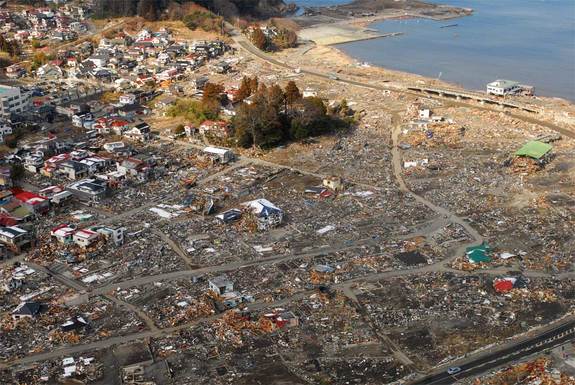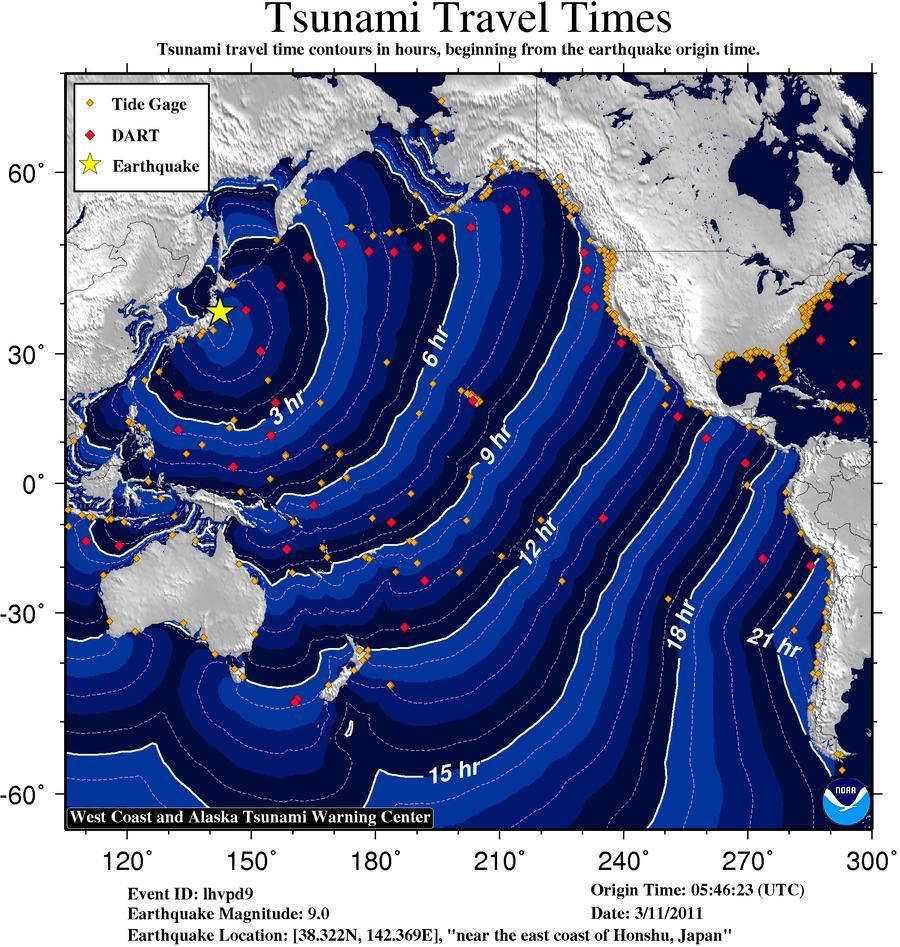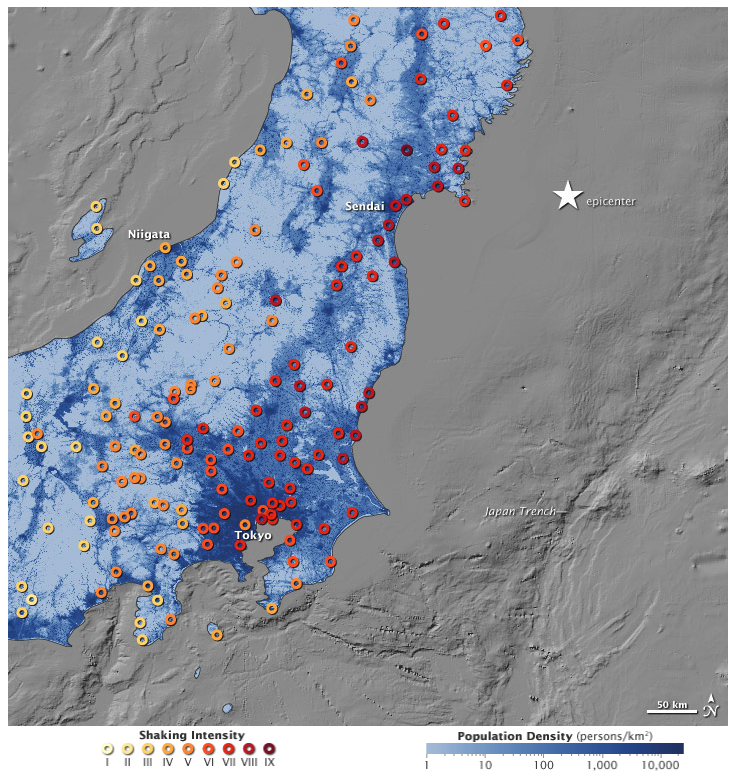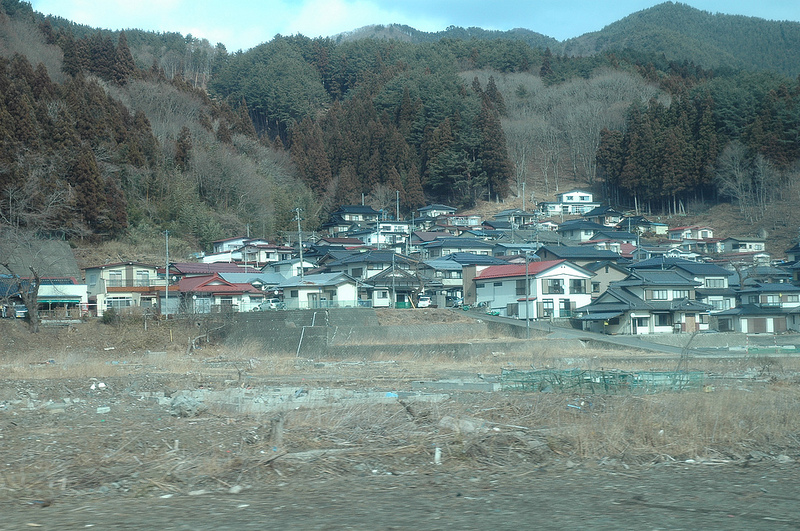Japan earthquake & tsunami of 2011: Facts and information
The Great Tohoku earthquake destroyed more than 100,000 buildings and triggered a nuclear disaster.

The Japan earthquake and tsunami of 2011, also known as the 2011 Tohoku earthquake and tsunami or the Great Tohoku earthquake, was a natural disaster that shook northeastern Japan on March 11, 2011. The disaster began when a magnitude-9 earthquake shook the region in the early afternoon, unleashing a savage tsunami.
The effects of the great earthquake, which was the strongest in Japan's recorded history, were felt around the world, from Norway's fjords to Antarctica's ice sheet. Tsunami debris has continued to wash up on North American beaches years later.
In Japan, residents are still recovering from the disaster. As of November 2021, there were still about 39,000 evacuees who lost their homes; 1,000 of them were still living in temporary housing, according to Japan's Reconstruction Agency.
More than 120,000 buildings were destroyed, 278,000 were half-destroyed and 726,000 were partially destroyed, according to the agency. The direct financial damage from the disaster is estimated to be about $199 billion dollars (about 16.9 trillion yen), according to the Japanese government. The total economic cost could reach up to $235 billion, the World Bank estimated, making it the costliest natural disaster in world history.
Related: How Japan's 2011 Earthquake Happened

A surprise disaster
The unexpected disaster was neither the largest nor the deadliest earthquake and tsunami to strike this century. That record goes to the 2004 Banda Aceh earthquake and tsunami in Sumatra, a magnitude-9.1, which killed more than 230,000 people. But Japan's one-two punch proved especially devastating for the earthquake-savvy country, because few scientists had predicted the country would experience such a large earthquake and tsunami.
Japan's scientists had forecast a smaller earthquake would strike the northern region of Honshu, the country's main island. Nor did they expect such a large tsunami. But there had been hints of the disaster to come. The areas flooded in 2011 closely matched those of a tsunami that hit Sendai in A.D. 869. In the decade before the 2011 Tohoku earthquake, a handful of Japanese geologists had begun to recognize that a large earthquake and tsunami had struck the northern Honshu region in that year. However, their warnings went unheeded by officials responsible for the country's earthquake hazard assessments, Live Science previously reported. Now, tsunami experts from around the world have been asked to assess the history of past tsunamis in Japan, to better predict the country's future earthquake risk.
"For big earthquakes, the tsunami is going to be the big destructive factor," said Vasily Titov, director of the National Oceanic and Atmospheric Administration's Center for Tsunami Research in Seattle, Washington told Live Science. "But if the nation is prepared, warning and education definitely saves lives. Compare the human lives lost in Sumatra and Japan. It's about 10 times less."

The 2011 Tohoku earthquake
The 2011 Tohoku earthquake struck offshore of Japan, along a subduction zone where two of Earth's tectonic plates collide. In a subduction zone, one plate slides beneath another into the mantle, the hotter layer beneath the crust. The great plates are rough and stick together, building up energy that is released as earthquakes. East of Japan, the Pacific plate dives beneath the overriding Eurasian plate. The temblor completely released centuries of built up stress between the two tectonic plates, a recent study found.
The March 11 earthquake started on a Friday at 2:46 p.m. local time (5:46 a.m. UTC). It was centered on the seafloor 45 miles (72 kilometers) east of Tohoku, at a depth of 15 miles (24 km) below the surface. The shaking lasted about six minutes.
Scientists drilled into the subduction zone soon after the earthquake and discovered a thin, slippery clay layer lining the fault, according to a 2013 study in the journal Science. The researchers think that this clay layer allowed the two plates to slide an incredible distance, some 164 feet (50 meters), facilitating the enormous earthquake and tsunami.
Early warning
Residents of Tokyo received a minute of warning before the strong shaking hit the city, thanks to Japan's earthquake early warning system. The country's stringent seismic building codes and early warning system prevented many deaths from the earthquake, by stopping high-speed trains and factory assembly lines. People in Japan also received texted alerts of the earthquake and tsunami warnings on their cellphones.
Death toll of the 2011 earthquake and tsunami
The number of confirmed deaths is 19,747 as of December, 2021, according to the reconstruction agency. More than 2,500 people are still reported missing.
Less than an hour after the earthquake, the first of many tsunami waves hit Japan's coastline. The tsunami waves reached run-up heights (how far the wave surges inland above sea level) of up to 128 feet (39 meters) at Miyako city and traveled inland as far as 6 miles (10 km) in Sendai. The tsunami flooded an estimated area of approximately 217 square miles (561 square kilometers) in Japan, according to the National Oceanic and Atmospheric Administration .
The waves overtopped and destroyed protective tsunami seawalls at several locations. The massive surge destroyed three-story buildings where people had gathered for safety. Near Oarai, the tsunami generated a huge whirlpool offshore, captured on video.
The Fukushima nuclear meltdown
The tsunami caused a cooling system failure at the Fukushima Daiichi Nuclear Power Plant, which resulted in a level-7 nuclear meltdown and release of radioactive materials. The electrical power and backup generators were overwhelmed by the tsunami, and the plant lost its cooling capabilities.
"Fukushima was created by the tsunami. The earthquake was not a factor," Titov said. "Fukushima was designed for a tsunami smaller than the one we saw."
Very low levels of radioactive chemicals that leaked from Fukushima have been detected along the North American coast offshore Canada and California. Trace amounts of cesium-134 and cesium-137 (radioactive isotopes) were found in seawater collected in 2014 and 2015, Live Science reported at the time.

The response
In the tsunami's aftermath, Japan's Meteorological Agency was criticized for issuing an initial tsunami warning that underestimated the size of the wave. In some regions, such as Miyagi and Fukushima, only 58% of people headed for higher ground immediately after the earthquake, according to a Japanese government study published in August 2011. Many people also underestimated their personal risk, or assumed the tsunami would be as small as ones they had previously experienced, the study found.
Scientists from around the world descended on Japan following the earthquake and tsunami. Researchers sailed offshore and dropped sensors along the fault line to measure the forces that caused the earthquake. Teams studied the tsunami deposits to better understand ancient sediment records of the deadly waves. Earthquake engineers examined the damage, looking for ways to build buildings more resistant to quakes and tsunamis.
"The tsunami itself died out a long time ago, but the effects in Japan will be there for decades," Titov told Live Science.
Worldwide effects
The tsunami waves also traveled across the Pacific, reaching Alaska, Hawaii and Chile. In Chile, some 11,000 miles (17,000 km) distant, the tsunami was 6.6 feet (2 meters) high when they reached the shore, according to the Pacific Tsunami Warning Center.
Related: Weird Earth Movement After Japan Earthquake Finally Explained
The surge of water carried an estimated 5 million tons of debris out to sea, the National Oceanic and Atmospheric Agency reported. Japanese docks and ships, and countless household items, have arrived on U.S. and Canadian shores in the ensuing years. The U.S. Coast Guard fired on and sank the derelict boat 164-foot Ryou-Un Maru in 2012 in the Gulf of Alaska. The ship started its journey in Hokkaido.
Amazing facts
Here are some of the amazing facts about the Japan earthquake and tsunami.
- The earthquake shifted Earth on its axis of rotation by redistributing mass, like putting a dent in a spinning top. The temblor also shortened the length of a day by about a microsecond.
- More than 5,000 aftershocks hit Japan in the year after the earthquake, the largest a magnitude 7.9.
- About 250 miles (400 km) of Japan's northern Honshu coastline dropped by 2 feet (0.6 meters), according to the U.S. Geological Survey.
- The jolt moved Japan's main island of Honshu eastward by 8 feet (2.4 m).
- The Pacific Plate slid westward near the epicenter by 79 feet (24 m).
- In Antarctica, the seismic waves from the earthquake sped up the Whillans Ice Stream, jolting it by about 1.5 feet (0.5 m).
- The tsunami broke icebergs off the Sulzberger Ice Shelf in Antarctica.
- As the tsunami crossed the Pacific Ocean, a 5-foot high (1.5 m) high wave killed more than 110,000 nesting seabirds at the Midway Atoll National Wildlife Refuge.
- In Norway, water in fjords pointing toward Japan sloshed back and forth as seismic waves from the earthquake raced through.
- The earthquake produced a low-frequency rumble called infrasound, which traveled into space and was detected by the Goce satellite.
- Buildings destroyed by the tsunami released thousands of tons of ozone-destroying chemicals and greenhouse gases into the air.
Additional resources
- How to Build an Emergency Survival Kit
- Red Cross Tsunami Survival Guide
- Ready.gov – What To Do During An Earthquake
Bibliography
Vasily Titov, Chief Scientist of the National Oceanic and Atmospheric Administration's (NOAA) Center for Tsunami Research in Seattle, Washington.
“Status of Reconstruction and Reconstruction Efforts.” Japan Reconstruction Agency, Dec. 2021. https://www.reconstruction.go.jp/english/
P.M. Fulton et al. “Low Coseismic Friction on the Tohoku-Oki Fault Determined from Temperature Measurements,” Science, Vol 342, Dec. 2013. https://www.science.org/doi/10.1126/science.1243641
NOAA/ National Weather Service U.S. Tsunami Warning System. https://www.tsunami.gov/
Japan Tsunami Marine Debris. NOAA Marine Debris Program. https://marinedebris.noaa.gov/disaster-debris/japan-tsunami-marine-debris
This article was updated Feb. 11, 2022 by Live Science Senior Writer Brandon Specktor.
Sign up for the Live Science daily newsletter now
Get the world’s most fascinating discoveries delivered straight to your inbox.











